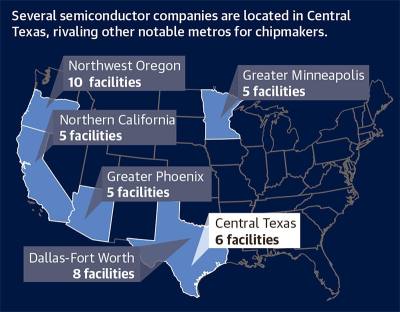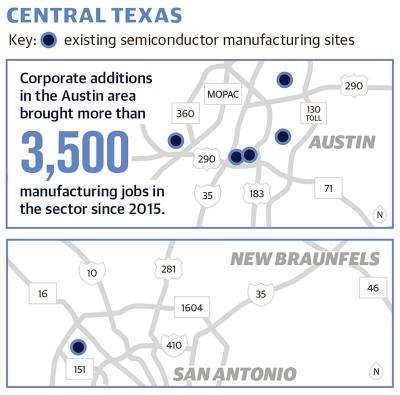Today, tiny semiconductor chips have a range of consumer, government and telecommunications uses and can be found in everything from toasters and cell phones to vehicles. Greater Austin has been a home to chipmakers since the 1970s, leading in part to its “Silicon Hills” moniker, and recent announcements led by more than $200 billion in potential investments by Samsung point to Central Texas as an influential industry hub.
Within that broader view, the Austin metro and areas along the I-35 corridor are poised to benefit from chipmakers’ activities. A handful of corporate expansions are expected to bring hundreds of billions of dollars and thousands of jobs in the years ahead. This could boost the regional workforce and economy as more chipmakers, other manufacturers and support companies arrive.
“I would say that we have one of the most dynamic semiconductor ecosystems in the United States,” said Ed Latson, executive director of the Austin Regional Manufacturers Association. “All that together really makes for a community that has a lot of capabilities, is playing in a lot of areas, and is really driving some of the advancement and technology that’s defining the space.”
Regional response
The past year has brought several major announcements in the semiconductor field led by one of Austin’s longest-tenured chip producers.
In November 2021, Samsung announced it will bring a $17 billion manufacturing facility and an estimated 1,800 jobs to Taylor. This summer, the electronics company’s plans to potentially drop an additional $167 billion and 8,200 jobs in Taylor as well as $24 billion and 1,800 jobs in the Manor area were also made public.
Analysts said the $200 billion-plus in confirmed and pending expansions are expected to bring wide-reaching economic effects ranging from new business and infrastructure to housing and population growth.
“The kind of jobs that are created, the kind of money that’s being invested, the supporting network and transportation, communications, and housing that have to go around these are really going to accelerate the pace of development,” Latson said.
In addition to Samsung, semiconductor equipment manufacturer Applied Materials is also eyeing a $2 billion expansion down the road in Hutto, and other related companies are or were considering the Greater Austin area for their operations.
Williamson County Judge Bill Gravell, who helped broker the deal that brought Samsung to Taylor, said that project will help propel millions of dollars of investments into the area.
“There is some real synergy in Williamson County because of the Samsung project,” Gravell told Community Impact.
While chipmaking is complex, analysts said regional effects tied to development, jobs and resources are not closed off to the high-tech industry.
One example is in New Braunfels, where Continental AG opened a $110 million automotive manufacturing facility in the fall. Jonathan Packer, president and CEO of the Greater New Braunfels Chamber of Commerce, said while Continental is not a chipmaker itself, the plant’s arrival is “absolutely critical” for its local economic effects.
“New Braunfels operates in a region,” Packer said. “What has been primarily kind of a metro economy in semiconductor with the Samsungs and the other folks, [Advanced Micro Devices], etc. that have been in Austin for many years, it’s now becoming a regional economy with built-out suppliers and more geographic diversity.”
A growing workforce
The Austin metro continues to outpace the rest of the country in job growth since the start of the COVID-19 pandemic, with more than 118,000 jobs—over 10% of the region’s total—added since February 2020, according to data from the Greater Austin Chamber of Commerce. In manufacturing, more than 5,200 jobs were added in the last year—a 7.9% increase.
Austin Chamber President and CEO Laura Huffman said the area’s strong jobs footing is also a key to increasing the chip industry in Central Texas.
“There’s a powerful case to be made that the region that includes the Austin region, the San Antonio region—on an economic basis—share a lot in common. Most prominently, perhaps, is a talent shed,” Huffman said. “When a company is looking at either locating or expanding anywhere in that super region, they’re thinking about the talent that’s available in that super region area.”
Overall job growth in the sector appears to continue as well. Over the summer, Applied Materials, AMD and Samsung all ranked in the chamber’s top 15 area employers for available job postings, with more than 2,100 combined.
Part of the region’s overall strength and capacity in the sector is the concentration of higher education and workforce training opportunities. Local economic and industry observers say the region’s colleges and universities can collaborate with local chipmakers and other companies to educate and train employees.
Local programs help attract skilled talent, which Latson said is a top concern in the semiconductor space today. The prevalence of training and education can also help area residents see higher wages and more opportunities of their own.
“Even if you’re not in the semiconductor industry or another advanced technology, the fact that your region is pursuing things that are future-leaning will be good for other businesses, for other activity, for the nonprofit community to be well-invested in,” Packer said.
Laura Marmolejo, Austin Community College’s assistant dean of advanced manufacturing, said the college has always maintained a close relationship with chipmakers with both non- and for-credit offerings across engineering and manufacturing fields. Those relationships and local offerings have helped to develop future talent as need grows across the supply chain, she said.
“Everyone is a customer to someone. Applied Materials makes equipment, which Samsung uses. Samsung uses equipment to build chips for other companies, [such as] Apple and Tesla and other people,” Marmolejo said. “You’ve got this hub of supplier-vendor relationships, not to mention you have extreme resources when it comes to skilled labor.”
Room for growth
The region is also set for gains within the industry in part thanks to the bipartisan passage of the federal CHIPS and Science Act this summer. It freed up more than $52 billion for semiconductor research, manufacturing, development and workforce initiatives, but how much could come to Texas has not been confirmed.
“I think this piece of legislation will impact Central Texas more than any other piece of legislation that’s been passed in my lifetime ... from a business perspective,” Latson said.
Huffman said seeking federal investments is now one of the Austin chamber’s “highest priorities.”
“Some of that money will go directly to companies ... but there’s also some research money, so it’s yet another opportunity for the private sector, the governmental sector and our higher education partners to go after some of these funds so that some of the most current, most forward-thinking research happens right here in Texas,” she said.
While that higher-level work is underway, existing investments and projections are leading to increased interest in locating business near future manufacturing centers.
Omar Nasser, principal at the real estate firm Aquila Commercial, said Samsung’s arrival in Northeast Austin “blew the lid off” the local industrial market as related vendors flocked to the area. The company’s planned Taylor expansion furthered that trend, and more businesses are now seeking space from Georgetown to San Marcos to get ahead of an expected wave of new development.
Nasser likened this activity to the prospecting that followed Tesla’s Austin announcement. The real estate firm is now tracking more than 5 million square feet of industrial space tied to the chips industry, Nasser said.
“A lot of these customers are considering, really, the region,” he said.
Although several signs point to a rising tide, regional stakeholders are also eyeing the potential of an economic downturn to dampen current trends. However, most agreed Central Texas is well positioned to weather such storms thanks to the number of people still moving to the area, the resources available and diverse industries.
Gravell pointed to interest rate hikes and an uncertain economy as the reason for a slowdown in home sales; however, he said commercial and infrastructure projects remain strong in the region.
County Commissioners also approved $500,000 in August for a county economic development partnership.
“We need to continue to do what we’ve done to get us where we are,” Gravell said. “Not every project is a natural fit for us, but there is more to come.”
Joe Warner contributed to this report.











